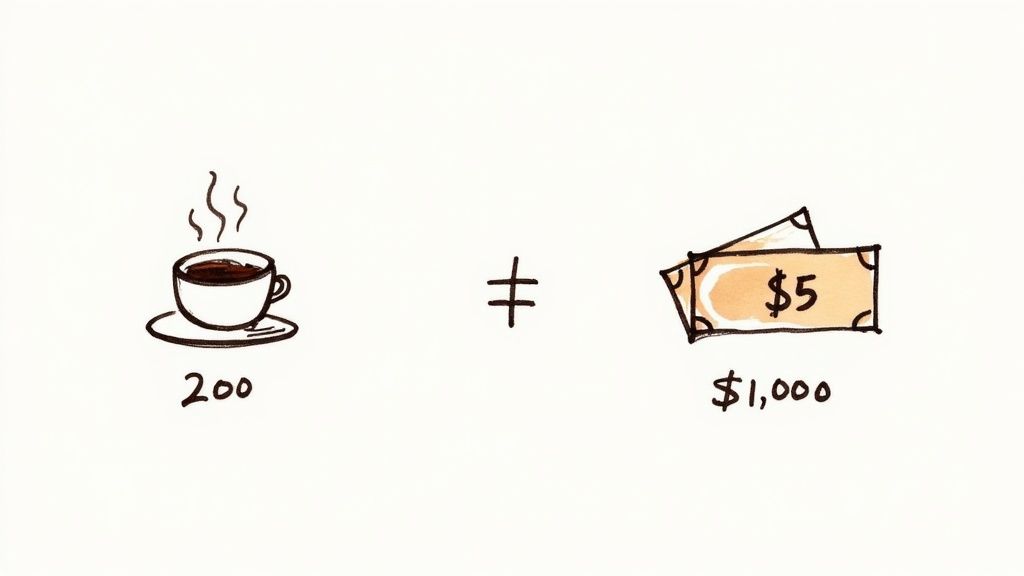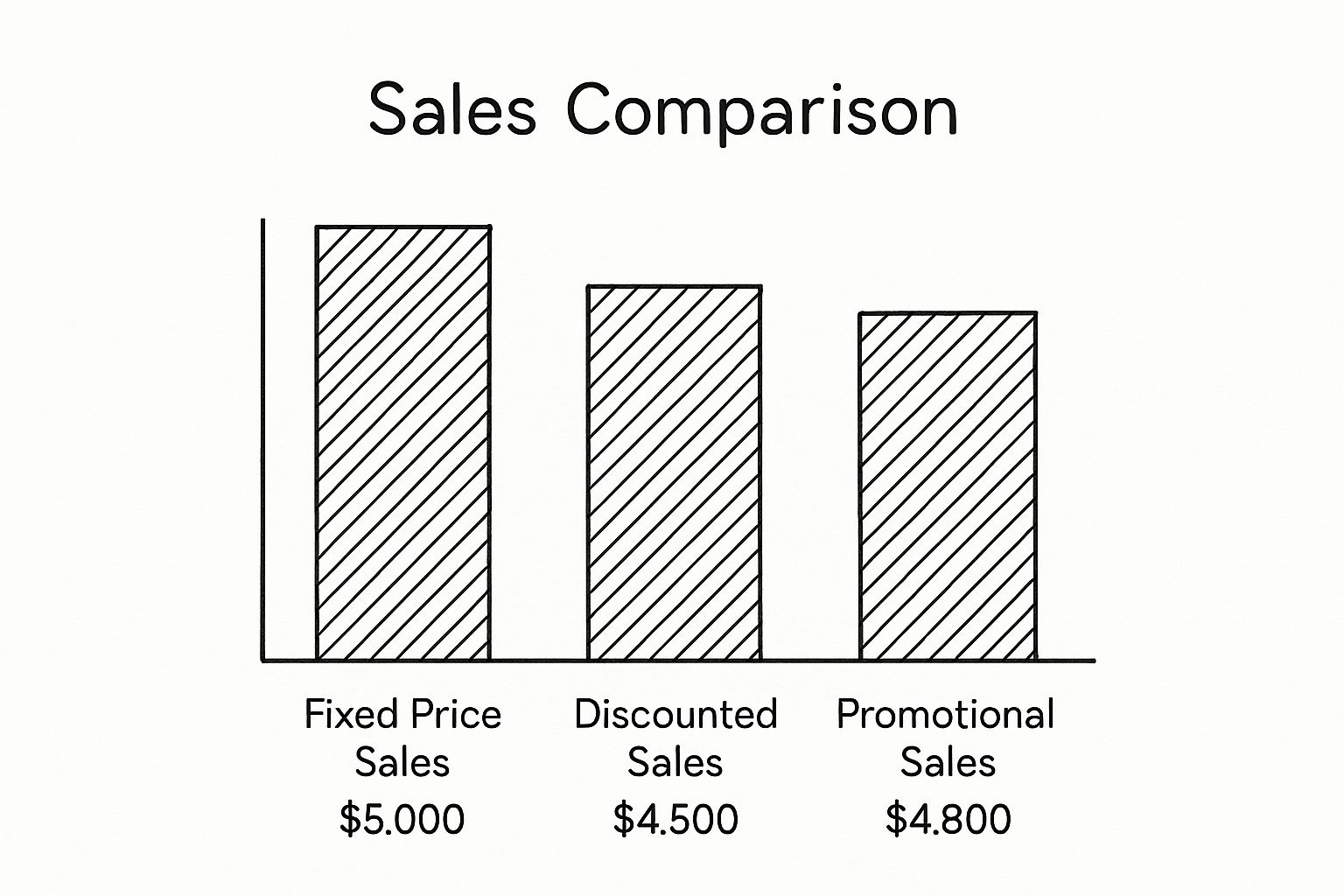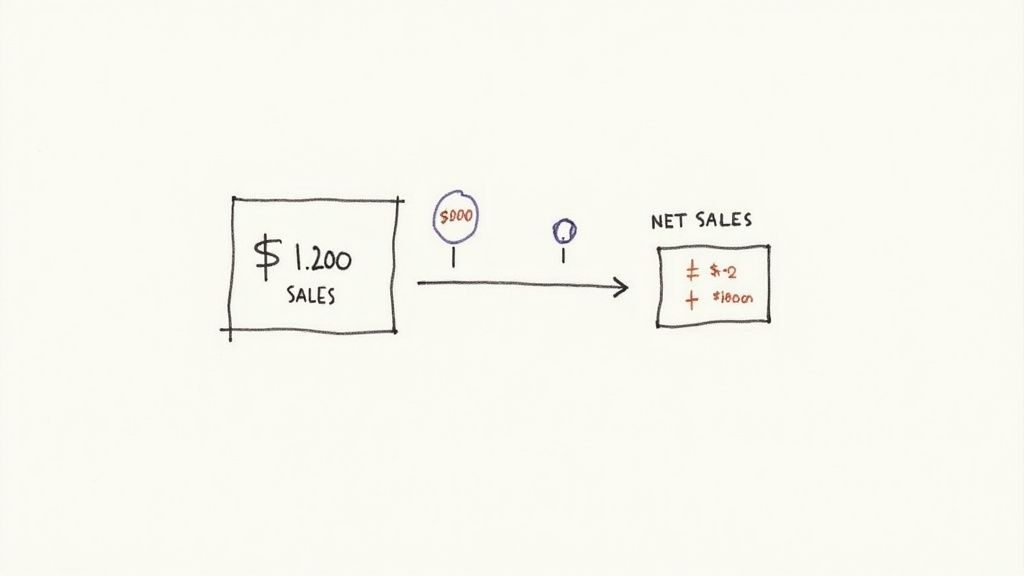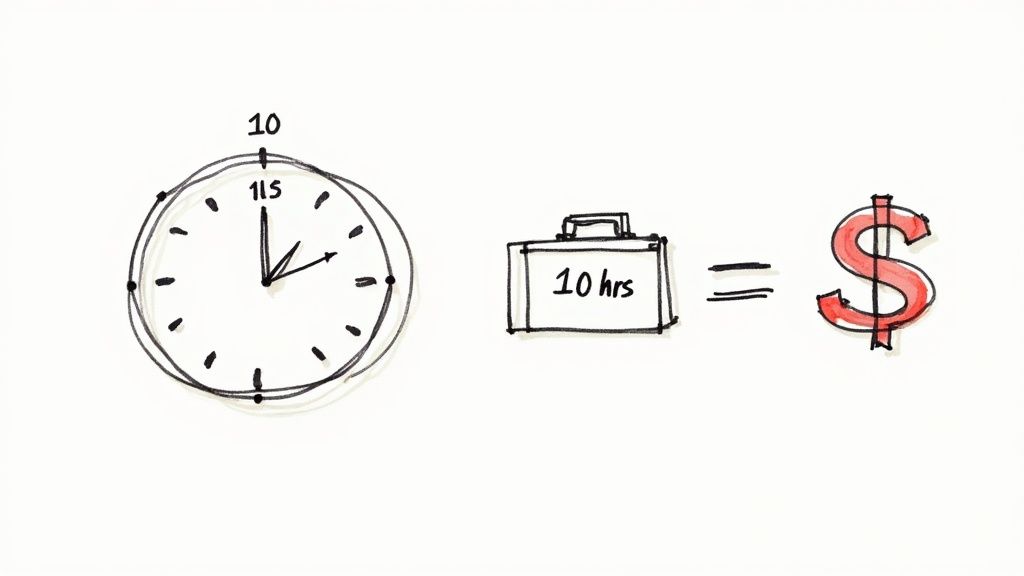To figure out your sales revenue, the core idea is pretty simple: you multiply the number of units you sold by the average price you sold them for. This process of calculating sales is fundamental to understanding your business's financial performance.
Let’s say you run a local bakery. If you sell 100 loaves of bread at $4 each, your sales revenue is $400. This quick math, often called a basic sales formula, gives you your top-line earnings, which is the starting point before you factor in any costs or deductions. Knowing how sales is calculated at this level is the first step.
Understanding the Sales Revenue Formula

At its heart, the calculation of sales revenue is the very first step in taking your business's financial pulse. It’s the total pot of money you've brought in from selling your products or services before a single expense gets taken out. This initial figure is what the pros call gross sales revenue. The sales revenue equation is the cornerstone of financial analysis.
The basic formula of sales revenue, or the sales revenue formula, is as straightforward as they come:
Sales Revenue = Number of Units Sold x Price Per Unit
This simple revenue calculation formula works for just about anything—physical products, software subscriptions, consulting hours, you name it. For example, if a SaaS company sells 10,000 subscriptions at $50 each, their total revenue of sales comes out to a cool $500,000. While it might look basic, this sales revenue calculation is the backbone for understanding the income from your core business activities. Many refer to this as the sales units formula.
The Key Components of the Formula
To nail this calculation and understand how to find sales, you really only need to get a handle on its two main parts.
Before we dive deeper, here's a quick look at the core variables you'll be working with in one of the most fundamental sales formulas.
Core Components of the Sales Revenue Formula
Getting these two numbers right is the key to seeing how well your business is performing at a glance and answering the question, "how do i calculate sales?"
People often get tripped up on the difference between "sale and revenue." Think of it this way: sales is a revenue, but it specifically points to the money made from what your business actually does—its main gig. "Revenue" is a bigger umbrella that can also include income from other sources, like investments. The relationship between sales and sales revenue is direct and crucial.
From Gross Sales to a Clearer Picture
While the gross formula for sales gives you that big, exciting number, it doesn't quite tell the whole story. To get a more honest look at your earnings and determine your net sales to revenue, you need to move from gross to net sales. This means subtracting things like customer returns, allowances for damaged goods, and any discounts you offered.
It's also super insightful to calculate percentage of revenue that each of your products contributes. This helps you see what's really driving your success. For a deep dive on that, check out our guide on sales percentage calculations. Getting your gross revenue is just the first step on a much bigger journey to understanding your business's financial health.
How to Accurately Calculate Your Gross Sales Revenue
The basic revenue sales formula is a neat starting point, but let’s be real—business is rarely that simple. What happens when you're juggling variable pricing, seasonal promotions, or a handful of different product tiers? An accurate gross sales equation means you have to track every single transaction consistently, no matter the final price. Knowing how to determine sales revenue accurately is key.
Think about a software company with three different subscription plans. You can't just multiply one price by one quantity. Instead, you have to add up the revenue from each tier on its own.
Here's how is sales revenue calculated in that scenario:
- Tier A: 100 subscribers at $20/month = $2,000
- Tier B: 50 subscribers at $50/month = $2,500
- Tier C: 10 subscribers at $100/month = $1,000
To get your monthly total sales equation, you just add up those streams: $2,000 + $2,500 + $1,000 = $5,500. That’s the proper way to figure out your sales revenue when you have multiple price points in the mix.
Tracking Sales When Discounts and Promotions Are in Play
Now, let's switch gears to a retail store running a big seasonal sale. This is a common tripwire for businesses when it comes to sales revenue calculation. The golden rule here is to record the actual sale price, not the original sticker price.
If you sell 200 jackets that normally go for $100 but are discounted by 20% to $80, your revenue is $16,000 (200 x $80). It's not $20,000. It's a simple distinction, but forgetting it inflates your numbers and paints a dangerously rosy picture of your performance. Nailing the relationship between sales to revenue means logging the money that actually hits your bank account.
This infographic breaks down how different pricing strategies affect your final gross sales, really driving home the point of tracking each sale's true value.

As you can see, discounts and promos are great to calculate sales volume, but they also chip away at your top-line revenue for each transaction.
The Right Tools for a Flawless Sales Equation
So, how do you find sales revenue without pulling your hair out? The non-negotiable answer is consistent data tracking. Human error is one of the biggest threats to an accurate calculation of sales revenue, so leaning on the right tools is a must.
- Spreadsheets: If you're just starting out, a well-organized spreadsheet is your best friend. Set up columns for the date, product, quantity, unit price, and total sale. This hands-on approach forces you to really understand how sales is calculated at its most basic level.
- Point of Sale (POS) Systems: For any retail or restaurant business, a modern POS system is a total game-changer. It logs every sale at the correct price automatically, keeps tabs on inventory, and spits out detailed sales reports. It basically automates the sales revenue equation and slashes the risk of errors.
- Accounting Software: Once your business starts to scale, dedicated accounting software is no longer a "nice-to-have"—it's essential. These platforms sync with your bank accounts and POS systems to give you a complete financial overview, making the whole process of how to calculate sales in accounting much more straightforward.
At the end of the day, the principle is simple: your system has to capture the final transaction price for every single sale. If that data isn't solid, any financial analysis you do later—from profit margins to how to calculate the return on sales—will be built on a house of cards.
What About Service-Based Businesses?
The exact same logic applies if you're selling services instead of physical products. The only thing that changes is your "unit." For a consultant, a unit might be an hour of work. For an agency, it could be a completed project or a monthly retainer. The required service revenue formula is still just the number of units (hours, projects) multiplied by their price. Knowing how to calculate service revenue is crucial.
It's also incredibly helpful to know how to figure percentage of sales for your different service offerings. You might discover that while one-off projects bring in big paydays, it's your recurring retainer clients that make up the largest percentage of your stable, predictable income. If you need a hand crunching those numbers to calculate revenue percentage, a reliable online tool can make it easier to figure out a percentage of revenue.
No matter what you sell, mastering how to get sales revenue right starts with impeccable record-keeping. Whether you're using a simple spreadsheet or a sophisticated POS, the goal is the same: capture the true value of every transaction to build a financial snapshot of your company you can actually trust.
Moving from Gross to Net Sales Revenue

Your gross sales figure is a great starting point—it's that big, exciting number that shows initial demand. But let's be real, it's not the number that pays the bills. For that, you need to get to your net sales revenue, which is the money you actually keep after the dust settles.
This is where the relationship between raw sales and sales revenue gets much clearer. The key is a simple but critical formula for net sales revenue that every business owner should know by heart.
Net Sales = Gross Sales - Sales Returns - Sales Allowances - Sales Discounts
This simple net sales revenue equation cuts through the noise. It takes your top-line gross sales and refines it into a realistic measure of the income you've truly earned. Getting comfortable with calculating net sales revenue is a fundamental step toward accurate financial reporting and making smarter business decisions.
Deconstructing the Deductions
To run this calculation properly, you have to get familiar with each piece you're subtracting from your gross sales. Think of these not as business expenses, but as direct reductions from your top-line revenue.
Sales Returns: This one's the most obvious. It’s the total value of products that customers sent back for a full refund. A customer returns a $50 sweater? Your gross sales just dropped by $50.
Sales Allowances: These are small refunds or price reductions you give customers for minor issues, like a product with a cosmetic flaw. Say a customer receives a table with a small scratch. You might offer a $25 allowance to keep them happy and avoid a full return.
Sales Discounts: This bucket includes all the incentives you offer, usually to encourage quick payment. That " 2% off if you pay in 10 days" offer on your invoices? Every customer who takes it is directly reducing the final revenue you collect.
It's also crucial to have a clear process for handling other deductions, which includes understanding chargebacks in accounting, as they can take a real bite out of your final revenue figures if not managed properly.
Calculating Net Sales Revenue in Action
Let's put this into practice with our retail store example. Imagine the store brought in $50,000 in gross sales last month. But during that same period, a few other things happened:
- Customers returned items worth a total of $2,500.
- The store issued $500 in allowances for minor product damages.
- Clients who paid their invoices early claimed $1,000 in discounts.
Now, we just plug these numbers into the formula for revenue calculation:
$50,000 (Gross Sales) - $2,500 (Returns) - $500 (Allowances) - $1,000 (Discounts) = $46,000 (Net Sales)
Just like that, the calculation of sales revenue reveals the store's actual top-line earnings were $46,000, not the initial $50,000. This is the accurate figure you need to start calculating other critical health metrics, like gross profit and overall profit margins. Nailing this is non-negotiable for a real view of your company's health. You can use a reliable profit margin calculator can simplify this next step to keep the momentum going.
Why the Distinction Matters
Knowing the difference between gross and net sales is more than just an accounting chore—it’s a powerful diagnostic tool for your business.
If you see a massive gap between your gross and net sales, it’s time to ask some tough questions. It could be a red flag pointing to problems with product quality (causing high returns), a flawed pricing strategy (forcing frequent allowances), or discount policies that are simply too generous and are eating away at your bottom line.
To make it crystal clear, let's break down the core differences between these two essential metrics.
Gross Sales vs Net Sales What's the Difference
This table compares these two essential revenue metrics to clarify what each reveals about your business's financial health.
By diligently tracking and calculating net sales revenue, you move past vanity metrics and get a much clearer picture of your company's actual performance. This number is the true starting point for analyzing profitability and making the kind of informed strategic decisions that drive sustainable growth.
Calculating Revenue for Services and Projects

The classic revenue formula isn't just for businesses shipping physical products. If you're running a consultancy, agency, or freelance operation, the same rules apply—you just have to think a little differently about your "unit of sale." Instead of a widget, your unit is an hour of your time, a finished project, or a monthly retainer.
Figuring out how to calculate service revenue is absolutely vital for understanding the health of your business. The core revenue sales formula doesn't change: Quantity x Price. The trick is correctly identifying your quantity and price when what you sell is your expertise or creative output.
Different Billing Models and Their Sales Equations
Service businesses are rarely a one-size-fits-all affair. Your sales equations will look different depending on how you bill clients. Let's break down the three most common models I've seen in the wild.
- Hourly Billing: This is the most straightforward model. A freelance web developer who bills 120 hours in a month at $100 per hour has a simple sales equation: 120 hours x $100/hour = $12,000 in monthly revenue.
- Project-Based Billing: Here, the entire project is your "unit." If a marketing agency wraps up three website redesigns in a quarter, each priced at a flat $15,000, the revenue calculation formula is just as simple: 3 projects x $15,000/project = $45,000.
- Retainer Agreements: For ongoing work, the unit is the monthly fee. An SEO consultant with eight clients on a $2,000 monthly retainer calculates their revenue like this: 8 clients x $2,000/month = $16,000.
No matter which model you use, knowing how to count sales properly hinges on having a crystal-clear scope of work and solid client agreements. This is where strong proposals are worth their weight in gold. If you need some inspiration, checking out different sales proposal templates can offer helpful guidance.
The Challenge of Revenue Recognition for Long-Term Projects
Now, things get a bit tricky with long-term projects. Let's say your agency lands a six-month contract worth $60,000. Do you book all $60,000 as revenue in month one? Absolutely not. This is one of the most common pitfalls when learning how to calculate sales in accounting for service-based companies.
Proper accounting standards, like ASC 606 in the US, are very clear: you recognize revenue as it is earned. If you complete roughly one-sixth of the project in the first month, you should only recognize $10,000 of that revenue for that period.
This principle of "revenue recognition" isn't just a suggestion—it's critical for accurate financial reporting. It ensures your income statements reflect the work you've actually done, preventing a dangerously inflated view of your monthly performance and helping you avoid major cash flow headaches down the road.
To manage this, many firms use the percentage-of-completion method. You estimate the total effort needed for the project and then recognize revenue proportional to the work you've knocked out during each accounting period.
Aggregating Multiple Service Revenue Streams
Most successful service businesses aren't one-trick ponies. The true calculation of sales revenue usually involves adding up different income streams. Take a digital marketing agency’s typical month, for example:
- Retainers: 10 clients at $2,500/month = $25,000
- Project Work: One-off social media campaign for $5,000
- Hourly Consulting: 20 hours at $150/hour = $3,000
The agency’s total sales equation for the month is the sum of these parts: $25,000 + $5,000 + $3,000 = $33,000. This composite view gives a much more accurate picture of the business's financial engine.
This is exactly how massive professional services firms operate, just on a global scale. In fiscal year 2025, EY reported combined global revenues of around $53.2 billion. That massive number is the sum of all their service lines—consulting, assurance, tax services, and more—each with its own mix of fixed-fee projects and hourly rates. You can discover more insights about these financial breakdowns on ey.com.
At the end of the day, whether you're a solo freelancer or a global firm, the principle is the same. Mastering the formula of sales revenue comes down to clearly defining your sales unit, applying the right price, and recognizing that income only when it's truly earned.
Common Mistakes in Sales Revenue Calculation
Knowing the revenue sales formula is one thing. Actually applying it without any hiccups is a whole other ball game. This is where so many businesses, big and small, trip up, leading to messy financial data and questionable strategic moves. Even a tiny mistake in the calculation of sales revenue can send ripples through your entire business.
The classic blunder? Mixing up gross and net sales. It's easy to get attached to that bigger gross figure, but it’s the net number that tells the real story of your performance. Making decisions based on inflated gross revenue is like planning a road trip without factoring in the cost of gas—you're not going to get very far.
Another major landmine is sales tax. It’s absolutely critical to remember that sales tax isn't your money. You're just holding onto it for the government. Tossing it into your revenue calculation pumps up your top line and sets you up for a nasty surprise when tax season rolls around.
Overlooking Sales Deductions
If you’re not meticulously tracking returns, allowances, and discounts, you're on the fast track to inaccurate reports. These aren't just minor tweaks; they're direct hits to your top-line revenue.
- Returns: Every single product that comes back for a refund chips away at your earned revenue. If you're seeing high return rates, it might be a red flag for product quality or customer satisfaction issues.
- Allowances: Those price cuts for minor product flaws might seem small individually, but they add up, eroding the revenue on each sale. Ignoring them means you're overstating how much cash you actually brought in.
- Discounts: Whether they're for promotions or early payments, all discounts have to be subtracted. Forget to do that, and your sales revenue calculation will be off, throwing off other key metrics like how to calculate the return on sales.
This isn't just a headache for startups. Getting the formula of sales revenue right is crucial at any scale. Just look at the global car and automobile sales sector—it was projected to rake in around $4.36 trillion in 2025. That staggering number comes from a simple principle: multiplying the number of vehicles sold by their average prices. It’s a perfect example of how the basic sales revenue equation is both fundamental and incredibly powerful.
Data Entry and System Glitches
Bad data is the silent killer of financial clarity. A simple typo, a decimal point in the wrong place, or a sync failure between your POS system and accounting software can derail everything. This is why having a rock-solid process for record-keeping is non-negotiable.
The old saying "garbage in, garbage out" has never been more relevant. If your initial sales data is flawed, every financial metric that follows—from profit margins to growth forecasts—is built on a shaky foundation. Your entire financial analysis depends on the quality of those initial numbers.
Keeping your data clean and accurate is everything. If you're looking to get your records in pristine shape, getting a handle on data management basics is the best place to start. You can dive deeper with our guide on data hygiene best practices to build a more resilient system.
How to Bulletproof Your Calculations
Dodging these common mistakes isn't about achieving perfection—it's about having smart systems to catch errors before they snowball.
- Get Your Software Synced Up: Modern accounting software that integrates with your POS and e-commerce platforms can automate a huge chunk of the process. This dramatically cuts down on the risk of manual data entry errors.
- Make Audits a Habit: Block off time every month or quarter to actually review your sales data. Square up your reports with your bank statements to make sure everything lines up perfectly.
- Train Your Team: Make sure everyone who touches sales data—from cashiers to your finance team—understands how critical accuracy is and sticks to a consistent process.
By proactively sidestepping these pitfalls, you can trust that your sales to revenue figures are a true reflection of your business's health. That's what gives you the confidence to make the right strategic calls.
Answering Your Top Questions About Sales Revenue
Once you start digging into the numbers, a few common questions about sales revenue always seem to pop up. Nailing down these details is the key to getting a crystal-clear picture of your company's financial health. Let's tackle some of the most frequent ones I hear, including "how to calculate the sales revenue."
What's the Real Difference Between Sales and Revenue?
People throw these terms around interchangeably all the time, but there’s a small but critical difference. Here’s the easiest way to think about it: sales is a type of revenue, but not all revenue comes from sales.
Sales refers only to the money you make from your main business gig—selling your products or delivering your services. It's the core of what you do.
Revenue, on the other hand, is the bigger bucket. It includes all the income your business generates. That means it covers your sales, plus any other money coming in, like interest earned from an investment or rent from a building you own.
How Do I Figure Out the Revenue Percentage for a Single Product?
Knowing how to figure percentage of sales for each product is a game-changer. It instantly tells you who your star players are. The formula is pretty simple:
(Revenue from Specific Product / Total Sales Revenue) x 100
Let's say one of your products brought in $20,000 last quarter, and your total sales revenue was $100,000. That single product is pulling in 20% of your sales. This kind of data is gold for deciding where to spend your marketing budget and how to manage inventory.
This quick calculation is one of the most powerful strategic tools you have. When you know which products or services are your cash cows, you can double down on what's working and optimize everything from your pricing to your ad campaigns for maximum effect.
Of course, looking backward is one thing. When you're ready to look forward, you can dive into advanced sales forecasting techniques to start predicting future income.
Is Sales Revenue the Same Thing As Profit?
Nope. This is probably the most important distinction to get right in business finance. They are absolutely not the same thing.
Sales revenue is your "top-line" figure. It’s the total amount of cash that comes through the door before a single expense is paid. It's a great measure of market demand for what you offer.
Profit, on the other hand, is the "bottom line." It’s what's left over after you've subtracted every single cost from that revenue—think cost of goods sold (COGS), salaries, rent, marketing, taxes, you name it. It's entirely possible for a company to have a massive revenue of sales but be completely unprofitable because its expenses are out of control.
How Does Sales Revenue Get Recorded in Accounting?
When it comes to how to calculate sales in accounting, it all boils down to the "revenue recognition principle." This means you officially record revenue when it's earned, which isn't always when the money actually hits your bank account.
Here's how it generally works:
- For Products: Revenue is usually recognized right at the point of sale—the moment the customer officially owns the item.
- For Services: This one can be a bit trickier. For a one-off service, you recognize the revenue when the job is done. For a long-term contract, you often recognize it bit by bit over the life of the project.
In the books, a typical sale involves debiting your Cash or Accounts Receivable account and crediting your Sales Revenue account. This simple entry makes sure the transaction is properly logged on both your income statement and balance sheet, keeping your entire financial picture in balance.
Ready to supercharge your sales efforts? PlusVibe offers an AI-powered platform to help you create hyper-personalized cold email campaigns that hit the inbox and get replies. Scale your outreach, manage prospects, and make informed decisions with our intuitive dashboard. Start growing your business with PlusVibe today!














































.jpeg)


.png)























































